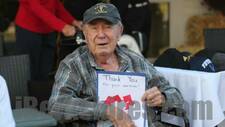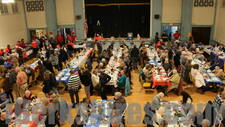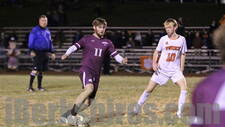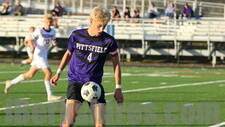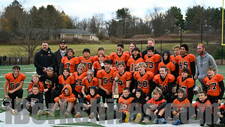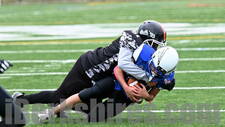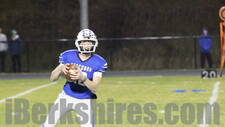Ambulance Service Seeking Instruction AccreditationBy Susan Bush
12:00AM / Sunday, November 27, 2005
 | | North Adams Ambulance Service Manager Michael Gleason |
North Adams – The North Adams Ambulance Service is seeking state accreditation as an emergency medical technician teaching facility. If accreditation is secured, the service will be the only Berkshire region entity able to offer basic and intermediate level EMT instruction.
The accreditation process is underway, and a state inspection of the 10 Harris St. ambulance service headquarters is scheduled for Nov. 29, said NAAS Manager Michael Gleason, who is also a certified paramedic.
EMT Training Possible
“We are hoping to become accredited as a teaching facility,†Gleason said during a Nov. 27 interview. “There is significant interest [in EMT training] here in the area and I am hoping that we can train some of the local people. Local people doing local work has always been important to me.â€
If the service is approved as a training venue, NAAS Training Officer John Meaney would lead EMT education. Meaney has earned state certification as an EMT instructor and coordinator, Gleason said.
As of June 30, only training programs accredited by the state Department of Public Health Office of Emergency Medical Services are permitted to offer initial EMT education opportunities.
At present, EMT instruction opportunities involve traveling to venues such as the Greenfield Community College in Greenfield, the Springfield College in Springfield, or the Hudson Valley Community College in New York.
Most EMT basic level instruction requires 120 hours of learning followed by a state certification examination; elevating to an intermediate EMT status requires an additional year of instruction and a state exam, Gleason said.
An additional two years of intense instruction is required to achieve paramedic status, Gleason said.
NAAS A "Paramedic Level" Service
Of the 38 EMTs employed by the service, 12 are certified paramedics, which permits the ambulance service to staff each shift with two paramedics.
“We are very lucky in that we have these paramedics,†Gleason said.

North Adams Ambulance Service Paramedic David Moresi |
The ambulance service employs eight full-time EMTs; the remaining EMTs work in a part-time capacity, Gleason said. The NAAS staff includes basic and intermediate level EMTs, he said.
EMTs certified at the basic level are able to administer oxygen, apply splints, offer wound care, bandage wounds, provide basic airway management, deliver cardiopulmonary resuscitation, and operate a semi-automatic defibrillator, Gleason said.
Intermediate levels EMTS may handle advanced airway management, start intravenous treatments, and possess a higher level of trauma assessment skill.
Paramedics may administer medications used during cardiac care, instances of seizure, diabetic emergencies, respiratory situations, pain control, and in cases of specific drug overdoses, paramedics may administer Narcan. Paramedics are also able to administer charcoal, used to absorb ingested substances, when necessary, and are also able to utilize a specific electrical therapy that “paces†the heart in a similar manner as a pacemaker.
Paramedic actions are almost always directed by a physician, and are always governed by a strict protocol established by state officials, said paramedic David Moresi.
Moresi said that the NAAS is a highly skilled organization that functions as “a well-oiled machine.â€
“It’s impressive,†Moresi said. “We do not have the call volume of some of the ambulance services in the state, and we have less crime calls [gunshot wounds, knife wounds], but we are comparable at every other level to any ambulance service in the state.â€
Changes in City Impact NAAS
The “changing face†of the city has changed the nature of ambulance service calls, Moresi and Gleason said.
EMTs respond to about 3,500 calls per year. Drug and alcohol related calls have decreased dramatically over the past three years, Moresi and Gleason said, and both cited the city’s economic and cultural shift as a catalyst for the ambulance call changes.
“The changing face of North Adams is apparent in this line of work,†Moresi said. “We used to have a lot of frequent fliers, and a lot of those people we don’t see anymore. There are agencies that are dealing with them."
“We used to handle at least three calls a night on weekends for drunks,†Gleason said. “We don’t see that anymore, and our drug ODs [overdoses] are maybe three a week.â€
Gleason explained that drug overdoses do not necessarily involve substances such as heroin or cocaine; the “ODs†most often involve a person who may have ingested too much of a prescribed medication or an over-the-counter medication such as aspirin.
An aging city population and an influx of new residents means “we are dealing with legitimate medical calls,†said Moresi.
And the ambulance service is capable of meeting the emergency medical needs of a changing demographic, he said.
“We are poised to meet the needs of this community no matter what changes development may bring,†Moresi said.
Years and Years of Combined Experience
The service is staffed with many veteran EMTs whose combined experience totals well over 100 years. Gleason has been with the NAAS since 1987, Moresi has a decade of experience, and the service includes long-time EMTs George Beckwith, Robert Dobbert, and Francis Millard, whose combined service is nearly 60 years.
“I can honestly say that the ambulance service has reached the level we are at because of the EMTs and the Board of Directors,†Gleason said. “We would not be where we are without the people who do this job and do it well.â€
The ambulance service is privately operated and is governed by a Board of Directors. Barbara Wagner serves as the board president.
The service owns three ambulances. Two ambulances are conventional in appearance, the third is a SUV dubbed “Medic 1†that is licensed as a paramedic ambulance. All three ambulances are paramedic-equipped, meaning each ambulance hosts sophisticated equipment used by paramedics.
The two standard ambulances are staffed from 8 a.m. to 10 p.m. daily; two basic level EMTs or one basic level EMT and one intermediate level EMT are usually assigned to one ambulance and a paramedic accompanied by a basic or intermediate level EMT are assigned to the other ambulance. Many medical calls are handled safely, competently, and appropriately by basic or intermediate level EMTs, Gleason said, and added that basic level EMTs are a needed and valuable NAAS resource.
"We Are Our Own Support Group"
EMTs are often faced with serious illness or injury and while efforts to save life often approach heroic proportions, not every life can be saved, Gleason said.
“EMTs do not ‘get used to it,’†Gleason said of deaths. “Anytime there is a traumatic death, there are those who take it hard. We do debriefings. We are our own support group. People [responding EMTs] start to second-guess themselves and that’s where we have to support each other."
Gleason recalled one of his first emergency calls, which occurred during 1983 while he serving as a “first responder†with the Florida Volunteer Fire Department. The call involved a two-year-old boy with significant injuries.
“That was over 20 years ago and I still remember that child’s name,†Gleason said.
The child did recover from his injuries.
“The situations that involve kids or young people; those are the ones that get to any of us that are parents," Gleason said. “Sometimes somebody does have to step away and regain their composure.â€
On The Front Lines
EMTs are often on the front lines of rescues and may find themselves walking along very rough terrain in dismal weather conditions. Gleason noted that ideally, 16 people are necessary to carry one person from the woods. When a rescue requires use of a “stokes basket,†the basket should be carried by eight people –four on each side of the basket- and there should be a team present to take over for the team that is carrying someone from the woods in a basket, Gleason said.
“And the last time we did a rescue like that, we had to rescue two people,†he said.
EMTs may find themselves relying on ingenuity when out on a call, Gleason said, and noted that he is aware of situations that called tree branches and even an old-fashioned popcorn popper into action as splints. In many cases, basic skills coupled with a quick mind are the EMT’s most effective tools, Gleason said.
“There are times, even at the paramedic level, that you need to be able to fall back on your basics, and that’s a sign of a good medic, to be able to drop back and rely on the basics,†he said. “And sometimes you have to make do with what you have available to you at the moment. The best EMT is someone who is very resourceful and can make something out of nothing.â€
Additional information about the North Adams Ambulance Service is available by calling 413-664-4933.
Susan Bush may be reached via e-mail at suebush@iberkshires.com or at 802-823-9367.
|





